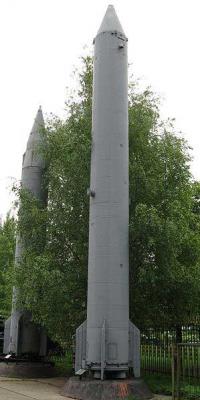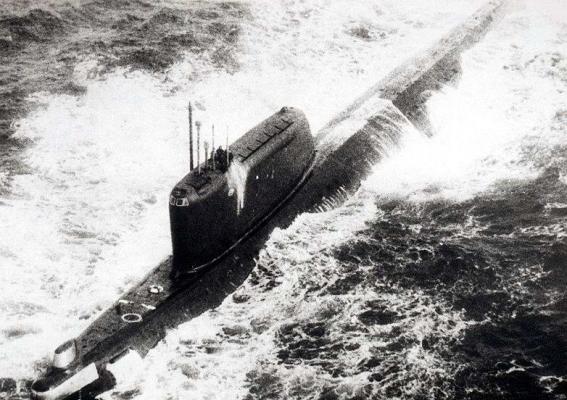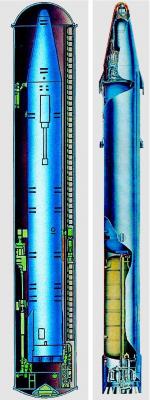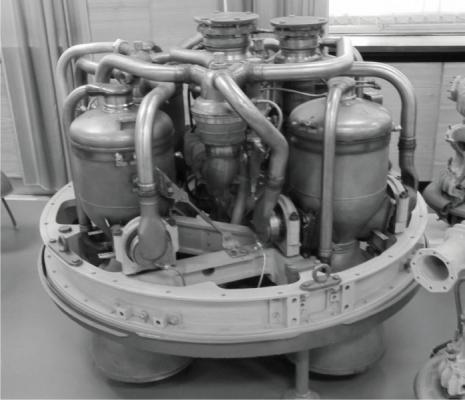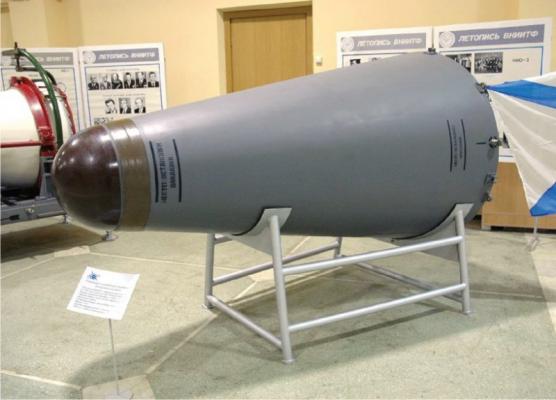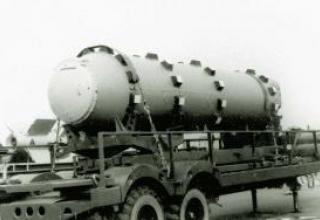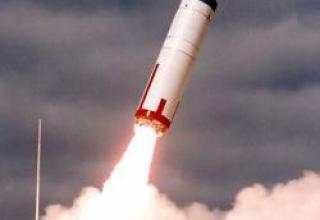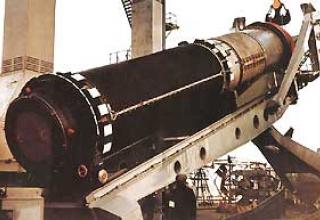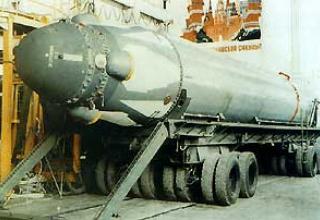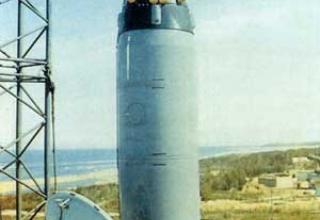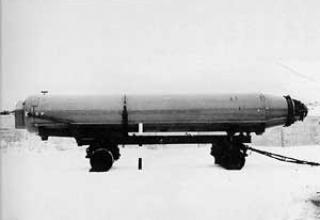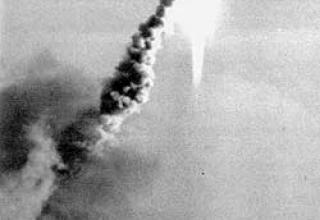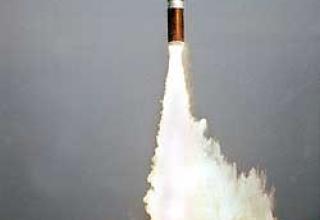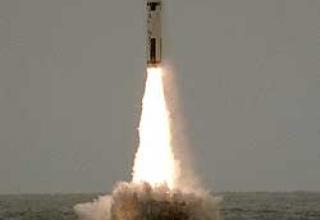R-21 (index of the Main Rocket and Artillery Directorate - 4K55, according to the classification of the U.S. MOD and NATO - SS-N-5) - Soviet liquid single-stage ballistic missile for submarines. The D-4 missile system was part of the armament of 629A (diesel-electric) and 658M (nuclear) project submarines. The decision to begin work on the R-21 missile - historically the first Soviet submarine SLBM with a submarine launch - was taken March 20, 1958. The development was carried out by the Design Bureau-586 under the supervision of Chief Designer M.K. Yangel, which at that time also carried out work on a missile for submarines R-15 with a surface launch, medium-range ballistic missile R-14 and intercontinental ballistic missile R-16. The new missile was to significantly increase the survivability of Soviet submarine missiles, saving them from the need to stay on the surface of the ocean for a relatively long time to launch a set of missiles (as, for example, on ships with SLBMs R-13) - taking into account the small range of missiles and the dominance of the anti-submarine forces of NATO, it could with a high probability lead to the death of the ship and failure to fulfill its combat mission. Based on the results of the review of the R-15 project in the Research Institute-88 and Naval institutes, as well as taking into account the results of work in SKB-385 on the project of ballistic missile of submarines R-13M with underwater launch it was decided that it is not expedient to continue these works. December 3, 1958 was issued a decree of the Council of Ministers of the USSR to terminate work on the R-15 missile in the Design Bureau-586, and in return he was entrusted with the development of a missile with underwater launch R-21. The R-21 conceptual design was created jointly with the Leningrad design bureaus that developed, respectively, the submarines (diesel-electric projects 629, Central Design Bureau-16, Chief Designer N.N. Isanin; nuclear projects 658, Central Design Bureau-18, Chief Designer S.N. Kovalev) and launchers (Design Bureau-1 of Central Design Bureau-34, Chief Designer E.G. Rudyak). In early 1959, the international situation sharply deteriorated as a result of the so-called "Berlin Crisis". The country's leadership demanded a maximum acceleration of the pace of development of the most important at that time due to its promising TTH weapons - R-14 and R-16 ballistic missiles: according to the resolutions of the Council of Ministers of 13 May 1959, the development of R-14 and R-16 missiles was accelerated in the OKB-586, and at the same time it was decided to transfer all work on maritime issues to SKB-385V. P. Makeev, who had already proved himself by working on the R-13 SLBM.
It should be noted that in the USSR, work on the creation of SLBMs with underwater launch did not start from scratch - the development of issues related to the underwater launch of the missile was asked back in 1955. February 3, 1955 was issued a government decree on the beginning of research on underwater launch of R-11FM missile. Work on the missile was assigned to OKB-10 Research Institute-88 under the guidance of Chief Engineer EV Charnko. The development of the onboard, bench and ship control systems was entrusted to SKB-626, Chief Designer N.A. Semihatov. The works on investigation of physics of the phenomena occurring at underwater launch were divided into three stages. The first stage involved the launch of models simulating the R-11FM missile from a fixed submerged mine. In the second stage, the mock-ups were launched from a moving converted submarine. At the third and final stage, the mock-ups were fired at full range from aboard the submarine. Two types of dummies were created for launch tests - solid propellant and liquid propellant rocket engines, respectively. On January 23, 1958, a government decree was issued to re-equip the B-67 submarine under the PV-611 project to launch experimental ballistic missiles with underwater launch. By July 1958, R-11FM was modified for submarine launch and received the index C4.7. The first launch of C4.7 from B-67 took place in August 1959 at the White Sea. The launch ended in failure. The launches were monitored by the Aeronaut. From the boat to the surface there was a cable-rope to the raft with an antenna. It was used to communicate in the VHF band with the observation vessel. It gave the signal to start. The boat's equipment signaled that the missile had left. However, the launch was not observed from the Aeronaut. The boat surfaced, the mine was opened and the rocket in it spontaneously started. The next attempt was made (again unsuccessfully) August 14, 1960 - in the process of filling the mine with water because of a factory defect in the system rocket dropped from the starting table and was lost head part. The first successful underwater launch of C4.7 ballistic missile in the USSR took place on September 10, 1960, 40 days after the first underwater launch of the American Polaris A-1 missile on July 20, 1960.
At the same time there was work on the R-21 missile itself. Its tests were also carried out in three stages - drop tests of layouts from the stand and the submarine and flight tests of the missiles themselves. For the launch tests was created a mock-up marked K1.1. Structurally, it was a prototype rocket R-21, which to reduce the engine run time were reduced volumes of oxidizer tanks and fuel. The tests were carried out from a fixed floating platform PSD-4 from depths of 40-50 meters. For the test from the submarine was re-equipped submarine C-229 on project 613-D4. One missile silo was installed on the boat behind the deckhouse, protruding from above to a height of 6.8 meters above the deck and from below to 2 meters behind the hull. In order to free up space for the missile silo it was necessary to dismantle some of the living quarters and one group of PL batteries. From May 15 to July 22, 1961 five launches of K1.1 mock-ups were made from the submerged stand of the PSD-4. From August 29 to September 11, three launches were made from the C-229 from a depth of 40-50 meters and the boat speed of 2.6-3.5 knots. The flight and design tests of the missile were continued with the launch of R-21 missiles from the submarine. The tests were conducted in the Northern Fleet since February 1962 from the board of the submarine K-142 re-equipped under the project 629B and delivered to the fleet December 29, 1962. On the boat of three shafts two bows were converted to R-21, and the third was closed with a plug. It was subsequently intended to install a solid fuel missile of the D-6 complex. SM-87 launchers with fixed tables of CKB-34 design were installed in the shafts under R-21. Underwater launch of the missiles could be carried out from a depth of 30-50 meters from the bottom of the missile, with a boat speed of 2-4 knots and sea disturbance up to 5 points. The first launch was carried out on February 24, 1962. A total of 15 launches were made during the flight and design tests, 12 of which were considered successful. Then began joint testing - missiles in the complex D-4 and the submarine. There were 12 launches, all of which were successful. The D-4 complex with the R-21 missile was adopted for service in accordance with Resolution of the Council of Ministers of the USSR No 539-191 of May 15, 1963.
Besides two pilot boats - C-229 of project 613-D4 and K-142 built under project 629B, 629A and 658M boats of project 629 and 658M respectively were re-equipped for D-4 missile system. The resolution of the Council of Ministers on conversion of Project 629 submarines into Project 629A was issued on July 2, 1962. The project provided for dismantling of three SM-60 launchers with R-13 missiles (D-2 complex) and installation of three SM-87 launchers instead of them, respectively. Due to the fact that the Navy allocated the first two boats only in 1964, the modernization work was delayed. The main submarine K-88 was rebuilt from August 30, 1964 to December 28, 1966. A total of 14 boats were rebuilt (including the K-142 of 629B project), 8 of them were rebuilt in the Northern Fleet at the Shipyard "Zvezdochka" and 6 at the Pacific Shipyard named after Lenin Komsomol. The modernization of 3 missile carriers was completed in 1967, 4 in 1968, 1 ship in 1969, 3 in 1971, and the last two were completed in 1972. Originally the D-4 complex was armed with boats of the Northern and Pacific Fleets. In the Northern Fleet, 629A project boats were part of the 16th Division of the 12th Submarine Squadron, based in Olenya Bay. Taking into account the commissioning of new nuclear submarines, diesel missile-carrying submarines from the Northern Fleet were gradually transferred to the other fleets of the country - in September 1968, two boats left for the Pacific Ocean, from 1971 to 1974 4 more.
By the end of 1970s the remaining missile-carrying vessels of the project 629A of the Northern Fleet were transferred to the Baltic Fleet. Since the late 1980s, according to the letter of the treaty on strategic offensive arms reduction OSV-1, the missile weapons on the missile carriers of this project were dismantled and the boats were disrupted or converted into torpedo and test ships. By the end of 1989, there were still 6 boats of this project in the Navy - 4 in the Baltic Fleet and 2 in the Pacific Fleet, but during 1990, all of them were taken out of service in the Soviet Navy. In addition to the 629A diesel-electric missile carriers, the D-4 complex was also equipped with the 658M nuclear submarines. In 1963-1967, of the eight missile carriers of project 658 with the D-2 missile system (R-13 missile), 7 boats, including the main K-19, were re-equipped for the new system. The K-145 submarine was not upgraded to D-4 and was subsequently re-equipped under the 701 project for R-29 missiles (6 SLBMs). The first two submarines of project 658 after their introduction into the Navy in 1961 were based in the Northern Fleet and became part of the 31st Division of the 1st submarine fleet based in West Face. In 1964, the 31st division became part of the 12th Squadron (later transformed into the 3rd Flotilla) of submarines of the Northern Fleet based in Gadzhievo, Saida Bay, Yagelnaya base. After the commissioning of Project 667A of the RSCS division, Project 658M missile carriers were transferred to the 18th Division, which was transferred to Gremiha in the late 1970s. Two Project 658 submarines - K-55 in 1968 and K-115 in 1963 - were transferred to the Pacific Ocean and served in Kamchatka as part of the 45th Nuclear Submarine Division. The peculiarity of the transfer of the K-55 was the presence of regular nuclear weapons on board. In accordance with the Treaty OSV-1, since 1977, began the removal of missile weapons from the submarines of Project 658M. In 1979, this procedure was completed on the lead submarine. From 1983 to 1987, the removal of missile silos was also carried out on the other boats of the project. The "former" missile carriers were converted into torpedo or special ships. Finally, all these boats were decommissioned in 1986-1991. Because of the short range of the missiles, the 629A and 658M project submarines were to serve off the U.S. coast, in the immediate area of the anti-submarine defense forces of their Navy. Due to the proximity of their targets, these missile carriers provided the missiles placed on them for short flight times, which made it difficult for the enemy to organize countermeasures against a missile strike.
One of the "Pacific" diesel-electric missile boats of the 629A project, the K-129, was lost during operation in March 1968. The boat went on combat duty on February 24, 1968, but it did not go into contact at the set time on March 8, 1968. It was lost approximately 1,400 km northwest of Oahu Island, Hawaii. During the Soviet Navy's search and rescue operation, the missile carrier was not found, which led to the belief that the missile carrier died for unexplained reasons with the entire crew. Subsequently, in July 1974, during the so-called Operation Jennifer (known in English sources as Project Azorian), the bow of the boat was raised from a depth of more than 5 km using a specially equipped Glomar Explorer. The final version of the death of the boat was never determined with certainty, but the cause of the malfunction with the P-21 rocket is missing. The government commission formed after the boat's death came to the most probable conclusion that the boat "fell" to the extreme depth of immersion due to the float valve malfunction in the RDP system while following the RDP (diesel engine under water). Among the alternative versions of the ship's death to this day is voiced quite possible - a collision in an underwater position with a U.S. submarine, which was carrying out covert tracking.
The R-21 was in service for over 25 years, from 1963 to 1989. In total, from 1963 to 1982, when the last launches were made, 228 launches of R-21 missiles were made, 193 of which were successful. The cause of 19 unsuccessful launches were failures of onboard equipment of missiles, in 11 cases - failures of supporting equipment and errors of personnel, the reasons for failures of 5 launches could not be established. R-21 missile of D-4 complex was a significant step forward in its technical level in comparison with its predecessor - R-13. For the first time in the USSR it was used for a submarine launch, which significantly increased the combat stability of the missile carriers. However, the D-4 complex was inferior in range to the American Polaris A-1 (range 2200 km) systems adopted 2.5 years earlier than the Soviet one, and Polaris A-2 (range 2800 km) adopted a year earlier. The accuracy of the American missiles was also significantly higher. In addition, the U.S. missile carriers could carry 16 missiles, against three missiles from Soviet ships. A very significant drawback was that the Soviet missile carriers had to make lifesaving 7-8,000 km of transition to combat patrol areas and operate in areas where the U.S. and NATO anti-submarine forces dominate, with significantly worse acoustic signatures from our ships (not to mention the need to regularly float up for long periods to recharge the batteries for the 629A project's DERPL). This led to the fact that despite the comparable number of missile carriers in the USSR and the U.S., the U.S. Naval Strategic Nuclear Forces had a much larger combat capability at the time. Unlike US missiles with solid rocket engines, Soviet missiles were equipped with liquid-propellant rocket engines. At the same time, despite the more complex design of the liquid-propellant missiles, the technical reliability of the Soviet missiles was comparable to that of the US missiles, and the power of the thermonuclear warhead was greater, which allowed to level out the gap in accuracy to some extent. The R-21 missile became a stage one, and the technical solutions tested there made it possible to start building more advanced missile systems with R-27 and R-29 missiles. Despite all these drawbacks, the created R-21 missile system enabled the Soviet missile carriers to become full-fledged units and successfully accomplish their tasks. In the course of operation of the R-21 missile carrier system, invaluable experience of combat patrols was gained, which later made it possible to create a highly effective naval component of strategic forces and, ultimately, to ensure nuclear parity with the United States in this class of weapons.
Composition:
Structurally, the R-21 missile was a single-stage liquid-propellant ballistic missile with an inertial control system and a detachable thermonuclear head end.
The missile is designed for combat use and storage in conditions of submarine navigation in case of possible ship tremors from depth bombing and nuclear explosion at a safe radius. The specifics of the submarine's launch required the sealing of the missile's compartments, electrical connectors, cables, pneumatic-hydraulic fittings under external seawater pressure. In this regard, the missile is designed as a single all-welded structure and consists of four compartments in series: instrument compartment, oxidizer tank, fuel tank, tail compartment with stabilizers (see diagram).
Communication of the control system equipment installed in the instrument compartment with the executive bodies (steering machines) is carried out by hermetic cables coming out of the compartment through special gromovods, the cavity of which is inflated with air from the so-called "bell" to ensure reliable tightness. Communication of the control system onboard equipment with the ship's test and start-up equipment is carried out through two special onboard leakproof connectors and replaceable cables.
The oxidizer and fuel tanks are designed to accommodate the fuel components and are simultaneously the rocket's power case. The tanks are separated by an inter-tank space, which communicates with the tail compartment through an annular gap between the tunnel and the consumables. This allowed the hydrostatic pressure on the missile's section to create an overpressure in the inter-tank cavity and avoid weight gain. For the same purpose, the oxidizer and fuel tanks during prelaunch operations provide the necessary back pressure of the external environment by means of pre- and prelaunch boosters.
Rocket engine - ZHRD S5.3 developed by OKB-2 (Chief Designer - A.M. Isayev), four-chamber, with a central turbo-pump unit, "open circuit". ZHRD worked on a pair of fuels: AK-27I nitric acid oxidizer (27% solution of nitrogen oxides in nitric acid) and TG-02 combustible.
The engine with automatic regulation of traction and ratio of fuel components. During the development of the engine a great attention was paid to the layout works to reduce the length in comparison with the R-13 rocket engine. As a result, the engine had one and a half times greater thrust and more than one and a half times shorter length at the same mid-range. This was the first engine in which the control moments were created by the main turning chambers rather than special steering chambers. The suspension units of the chambers allowed them to tilt by ±9°. To ensure a rational ratio of control moments on pitch, yaw and roll, the chambers' swing axles were shifted by 60° from the stabilization planes.
Unlike R-13 missiles, which were refueled on board the boat, R-21 missiles were submerged on the rocket carrier in the fueled state. At the beginning of operation, the shelf life of the refueled missile was six months, then according to the results of the complex operation and relevant research work this period was extended to two years. Structural performance of the engine, which does not require any checks and settings during operation, tightness from external pressure and a wide range of regulation provided reliable start of the engine under water and automatic maintenance of modes, both on underwater and surface areas of the trajectory. The engine was designed to stop in the event of an emergency shutdown with hermetic separation of fuel lines.
The weight of the detachable head part is 1179 kg, it was made according to the scheme of the blunted cone sphere. The casing of the unit and the charge are not combined. The decision to develop a new thermonuclear warhead was issued on January 28, 1960. The warhead was developed at the Research Institute-1011 (Chelyabinsk-70) under the supervision of Chief Designer A. D. Zaharenkov (later he was replaced by L. F. Klopov). KB-11 (Arzamas-16) was responsible for the creation of the thermonuclear charge, SKB-385 (Miass), the creator of the SLBM, SKB-885, and the impact sensor system was responsible for the research institute-137. The power was slightly reduced in comparison with the R-13 charge, but at the same time its weight was reduced by 400 kg.
To reduce overheating of the nose part during the passage of the atmospheric section of the trajectory, its sock had not a sharp point, but a rounded shape. The design and layout of the MS was significantly changed in comparison with the previous product for the R-13 missile, and it already had the features of promising warheads for domestic SLBMs, namely:
- no joints on the outer surface of the case;
- placement of the main components of the automatics on the bottom, which could be opened without disconnecting the electrical connections of the explosion and charge automatics;
- the possibility of performing finishing operations through the hatches on the bottom;
- implementation of the maximum possible weight and dimensions reduction, including through the use of case elements for fixing the automatics units.
The thermonuclear charge was tested at the Novaya Zemlya test site, and the warhead was fully tested in the Northern Fleet from March 1962 to March 1963. The warhead was headed by members of the State Missile Commission Yu. A. Shitikov (Navy). The tests were completed by testing the complex and the warhead at maximum range. The starting position of the PL was north of Nordkap Cape, and the battlefield where the HC arrived was in the area of Halmer Yu, north of Vorkuta. The missile tests lasted over a year. Shortly after, however, the developers of the charge proposed to increase its capacity by using tritium in the design. The Navy agreed with this proposal, but it was necessary to launch several more missiles. Such tests were organized by Northern Fleet Commander Admiral V. A. Kasatonov. This modification of the warhead was adopted for service in 1963. Due to the fact that the Navy had no experience in operating new thermonuclear charges of this type, at the initiative of the Navy introduced radiation control in missile silos using appropriate equipment. Later on, as the experience of operation accumulated, the radiation control in the mines was cancelled.
In addition to the R-21 missiles, the D-4 missile system included SM-87 launchers, a system of ship's shooting control devices, submarine equipment and systems that provide for the preparation and conduct of launch, in the development of which in addition to SKB-385 participated in the Design Bureau-2, TsKB-34, Research Institute-137, PA Arsenal. The use of missiles with submarine launches led to the need to create a special "holding system" that would hold the submarine within a given depth range during missile launches. Without this system after the launch of the missile the boat floated up to 16 meters, which led to the need to return the boat to a given depth to launch the next missile. Before the launch of the missile, the circular gap between the missile and the shaft was filled with tail water. In order not to unbalance the buoyancy of the submarine, the ring gap was filled with water from pre-filled special ring gap tanks using a pumping system. After the launch the buoyancy unbalance was created, which was eliminated by taking about 15 cubic meters of water into a special equalizing tank.
R-21 missiles were launched from a depth of 40-60 meters (counting from the bottom section of the missile) at a boat speed of 2-4 knots and the excitement of the sea to 5 points. The pre-launch preparation time of the first rocket for launch was about 30 minutes. Firing time of the three missiles is no more than 10 minutes. The missile silos had a diameter of 2150 mm and were mounted on the coamings of a strong hull of the boat. The R-21 missile was suspended in the shaft on special stretch-shock absorbers, and the tail part was installed on a special shock-absorbed launch table. The ship navigation system "Sigma-658" tracked the course, angles of onboard and keel swing, calculated the boat speed and provided continuous calculation of current coordinates. During the prelaunch preparation of missiles this data was transmitted to the counting and resolution devices "Stavropol-1" and "Emerald-1". On them, taking into account the data of "Sigma-658" system, corrections for Earth rotation and its sphericity, the calculation of angles of guidance of onboard gyro devices of the rocket relative to the firing plane and horizon plane, the calculation of the current distance to the target, the development of a temporary installation of the integrator longitudinal accelerations and issuance of these data on board the rocket. During the prelaunch preparation of the R-21 missile, the fuel and oxidizer tanks were pre-inflated to a pressure of 2.4 atmospheres. Then the mine was filled with water from the ring gap tanks, and the tanks were inflated to the pressure of 8.5 atmospheres. The so-called "air bell" was formed - a sealed air volume formed by the bottom bottom of the fuel tank and the starting table. The presence of the "bell" made it possible to dampen the gas-dynamic processes occurring during the launch, which led to the reduction of the power and heat loads arising during the launch from a blind mine without special gas vents to admissible values. The launch on the marshal engine did not require the creation of special shipborne devices necessary to ensure the exit of the missile from the mine and the water, and provided the possibility of controlled movement of the missile on an underwater section of the trajectory.
The shockless exit of the missile from the shaft of a moving submarine under the action of disturbances caused by the sea disturbance and rocking of the ship was ensured by the use of a bugel scheme of movement, structurally made in the form of rigid guides on the shaft, and bugels mounted on the missile body. After filling the mine with water, the pressure in the mine was equalized with the outboard one. The mine cover was opened. When the launch command was issued, the rocket engine was started. The launch was carried out with a reduced thrust, and access to the marching mode was carried out on a special cyclogram. The combustion products were fed into the "air" bell, which reduced the hydraulic impact. The pressure at the bottom section increased and pushed the missile out of the mine. The rods mounted on the missile slid on special rails and the missile came out of the mine. The lid of the missile silo would close. The containment system filled an equalizer tank to keep the boat at a given depth. The boat's shaft was drained and the next rocket was launched. The submarine launch using the missile's marching engine did not require any special launch devices and made it possible to control the missile's movement on an underwater section of the trajectory.
Characteristics:
| Maximum firing range, km | 1400 |
| The weight of the rocket maximum, kg | 16600 |
| HF power, Mt. | 1.0 |
| KVO, km | 2.8 |
| Dimensions, mm: - complete length - diameter |
12.9 1.4 |
| Missile motion parameters during launch | |
| Maximum pressure at startup, atm. | 9,0 |
| Maximum overload at startup, g | 3,7 |
| Movement time in the mine, s | 1,37 |
| Mine exit speed, m/s | 16,5 |
| Time to get out of the water, s | 3,0 |
| Output speed, m/s | 30,0 |
| Trajectory parameters when firing at maximum range | |
| Speed when the engine is switched off, m/s | 3439 |
| Height of the end of the active section, km | 68,9 |
| Flight time in the active area, s | 93 |
| Full flight time to target, s | 384,6 |
| Speed of meeting the head unit with the target, m/s | 342 |
Testing:
As of 01.01.1950, the factory batch of 230 shells was completed and sent to the Pavlograd test site.
In November 1949, pre-factory tests of 34 shells were carried out together with the fuse B-377 during which cases of missiles were revealed.
Special tests carried out to determine the causes of deficits showed that the most probable cause was an increased release of unburned reactive charge particles at the end of the active section of the trajectory.
In order to eliminate this phenomenon, in December 1949 a bench-top refinement of the engine was started with regard to aperture enhancement and ensuring that the powder charge was fixed in the chamber. After the end of the bench work and experimental firing for checking the reinforced aperture, the factory batch of projectiles was to be equipped with modified apertures on site and presented for factory tests in February 1950.
Sources:
- СКБ-385, КБ машиностроения, ГРЦ "КБ им. Академика В. П. Макеева" под общ. ред. В. Г. Дегтяря. М.: Государственный ракетный центр "КБ им. академика В. П. Макеева"; ООО "Военный Парад", 2007
- В. Ильин, А. Колесников. Подводные лодки России. М.: АСТ, 2004.
- Е.А.Шитиков "Ядерное противостояние: К истории создания боеголовок морских баллистических ракет". Вопросы истории естествознания и техники, №1, 1998.
- И.И. Величко, Е.М. Кутовой "Баллистические ракеты с ядерными боеголовками для подводных лодок" (http://flot.com/)
- Е.М. Мнев, В.Т. Чемодуров "О научном обеспечении подводного старта баллистических ракет" (http://flot.com/)
- Н.А. Семихатов, В.В. Чеботарев "Создание систем управления баллистических ракет подводных лодок" (http://flot.com/)
- Е.А. Шитиков "Ядерное оружие" (http://flot.com/)
- А.К. Чернышев "ВНИИЭФ-ДОСТОЯНИЕ И ГОРДОСТЬ РОССИИ" (http://vniief.ru/)
- И.А. Андрюшин, А.К. Чернышев, Ю.А. Юдин "Укрощение ядра. Страницы истории ядерного оружия и ядерной инфраструктуры СССР" / С., С.: Красный Октябрь, 2003.
- В.П. Макеев "БАЛЛИСТИЧЕСКИЕ РАКЕТЫ Р-13 и Р-21" (http://makeyev.msk.ru/)
- http://vniitf.ru/
- http://makeyev.ru/activities/missile-systems/1/RaketaR21/
